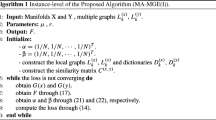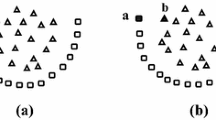Abstract
Building connections between different data sets is a fundamental task in machine learning and related application community. With proper manifold alignment, the correspondences between data sets will assist us with comprehensive study of data processes and analyses. Despite the several progresses in semi-supervised and unsupervised scenarios, potent manifold alignment methods in generalized and realistic circumstances remain in absence. Besides, theretofore unsupervised algorithms seldom prove themselves mathematically. In this paper, we devise an efficient method to properly solve the unsupervised manifold alignment problem and denominate it as extending generalized unsupervised manifold alignment (EGUMA) method. More specifically, an explicit relaxed integer programming method is adopted to solve the unsupervised manifold alignment problem, which reconciles three factors covering the updated local structure matching, the the feature comparability and geometric preservation. An additional effort is retained on extending the Frank Wolfe algorithm to tacking our optimization problem. Besides our previous endeavors we adopt a new strategy for neighborhood discovery in the manifolds. The main advantages over previous methods accommodate (1) simultaneous alignment and discovery of manifolds; (2) complete unsupervised learning structure without any prerequisite correspondence; (3) more concise local geometry for the embedding space; (4) efficient alternative optimization; (5) strict mathematical analysis on the convergence and efficiency issues. Experiments on real-world applications verify the high accuracy and efficiency of our proposed method.
Similar content being viewed by others
References
Li Z, Tang J. Unsupervised feature selection via nonnegative spectral analysis and redundancy control. IEEE Trans Image Process, 2015, 24: 5343–5355
Li Z, Tang J, He X. Robust structured nonnegative matrix factorization for image representation. IEEE Trans Neural Netw Learn Syst, 2018, 29: 1947–1960
Li Z C, Liu J, Yang Y, et al. Clustering-guided sparse structural learning for unsupervised feature selection. IEEE Trans Knowl Data Eng, 2014, 26: 2138–2150
Wang J, Feng W, Chen Y, et al. Visual domain adaptation with manifold embedded distribution alignment. In: Proceedings of ACM International Conference on Multimedia, 2018. 402–410
Peng X, Bai Q, Xia X, et al. Moment matching for multi-source domain adaptation. In: Proceedings of IEEE International Conference on Computer Vision, 2019. 1406–1415
Ji P, Qin D, Feng P, et al. Manifold alignment-based radio map construction in indoor localization. In: Proceedings of International Conference on Machine Learning and Intelligent Communications, 2018. 327–337
Tenenbaum J B, de Silva V, Langford J C. A global geometric framework for nonlinear dimensionality reduction. Science, 2000, 290: 2319–2323
Zhang K, Kwok J T. Clustered Nyström method for large scale manifold learning and dimension reduction. IEEE Trans Neural Netw, 2010, 21: 1576–1587
Roweis S T, Saul L K. Nonlinear dimensionality reduction by locally linear embedding. Science, 2000, 290: 2323–2326
van der Maaten L, Hinton G. Visualizing data using t-SNE. J Mach Learn Res, 2008, 9: 2579–2605
Chen J, Ma Z M, Liu Y. Local coordinates alignment with global preservation for dimensionality reduction. IEEE Trans Neural Netw Learn Syst, 2013, 24: 106–117
Wang C, Mahadevan S. Manifold alignment without correspondence. In: Proceedings of International Joint Conference on Artificial Intelligence, 2009
Abeo T A, Shen X J, Ganaa E D, et al. Manifold alignment via global and local structures preserving PCA framework. IEEE Access, 2019, 7: 38123–38134
Ham J, Lee D D, Saul L K. Semisupervised alignment of manifolds. In: Proceedings of International Conference on Artificial Intelligence and Statistics, 2005. 120: 27
Shon A, Grochow K, Hertzmann A, et al. Learning shared latent structure for image synthesis and robotic imitation. In: Proceedings of Neural Information Processing Systems, 2006. 1233–1240
Lafon S, Keller Y, Coifman R R. Data fusion and multicue data matching by diffusion maps. IEEE Trans Pattern Anal Mach Intell, 2006, 28: 1784–1797
Xiong L, Wang F, Zhang C. Semi-definite manifold alignment. In: Proceedings of European Conference on Machine Learning, Berlin, 2007. 773–781
Wang C, Mahadevan S. Manifold alignment using procrustes analysis. In: Proceedings of International Conference on Machine Learning, 2008. 1120–1127
Wang C, Mahadevan S. Heterogeneous domain adaptation using manifold alignment. In: Proceedings of International Joint Conference on Artificial Intelligence, Barcelona, 2011
Wang C, Cao L, Fan J. Building joint spaces for relation extraction. In: Proceedings of International Joint Conference on Artificial Intelligence, New York, 2016. 2936–2942
Pei Y R, Huang F C, Shi F H, et al. Unsupervised image matching based on manifold alignment. IEEE Trans Pattern Anal Mach Intell, 2012, 34: 1658–1664
Cui Z, Shan S, Zhang H, et al. Image sets alignment for video-based face recognition. In: Proceedings of IEEE Conference on Computer Vision and Pattern Recognition, 2012. 2626–2633
Cui Z, Chang H, Shan S, et al. Generalized unsupervised manifold alignment. In: Proceedings of Neural Information Processing Systems, 2014. 2429–2437
Frank M, Wolfe P. An algorithm for quadratic programming. Naval Res Logist, 1956, 3: 95–110
Quadrianto N, Song L, Smola A J. Kernelized sorting. In: Proceedings of Neural Information Processing Systems, 2009. 1289–1296
Haghighi A, Liang P, Berg-Kirkpatrick T, et al. Learning bilingual lexicons from monolingual corpora. In: Proceedings of the 46th Annual Meeting of the Association for Computational Linguistics, 2008. 771–779
Belkin M, Niyogi P. Laplacian eigenmaps for dimensionality reduction and data representation. Neural Comput, 2003, 15: 1373–1396
Hardoon D R, Szedmak S, Shawe-Taylor J. Canonical correlation analysis: an overview with application to learning methods. Neural Comput, 2004, 16: 2639–2664
Spielman D A, Teng S H. Smoothed analysis of algorithms. J ACM, 2004, 51: 385–463
Dantzig G B, Thapa M N. Linear Programming 1: Introduction. Berlin: Springer, 2006
Abraham R, Marsden J E, Ratiu T. Manifolds, Tensor Analysis, and Applications. Berlin: Springer, 2012
Beck A, Tetruashvili L. On the convergence of block coordinate descent type methods. SIAM J Optim, 2013, 23: 2037–2060
Tewari A, Ravikumar P K, Dhillon I S. Greedy algorithms for structurally constrained high dimensional problems. In: Proceedings of Neural Information Processing Systems, 2011. 882–890
Wolf L, Hassner T, Maoz I. Face recognition in unconstrained videos with matched background similarity. In: Proceedings of Computer Vision & Pattern Recognition, 2011
Cui Z, Li W, Xu D, et al. Fusing robust face region descriptors via multiple metric learning for face recognition in the wild. In: Proceedings of IEEE Conference on Computer Vision and Pattern Recognition, Portland Oregon, 2013. 3554–3561
Yamaguchi O, Fukui K, Maeda K. Face recognition using temporal image sequence. In: Proceedings of the 3rd International Conference on Face & Gesture Recognition, Nara, 1998. 318–323
Wang R, Shan S, Chen X, et al. Manifold-manifold distance with application to face recognition based on image set. In: Proceedings of IEEE Conference on Computer Vision and Pattern Recognition, 2008. 1–8
Cevikalp H, Triggs B. Face recognition based on image sets. In: Proceedings of IEEE Conference on Computer Vision and Pattern Recognition, San Francisco, 2010. 2567–2573
Hu Y, Mian A S, Owens R. Sparse approximated nearest points for image set classification. In: Proceedings of IEEE Conference on Computer Vision and Pattern Recognition, 2011. 121–128
Kim T K, Kittler J, Cipolla R. Discriminative learning and recognition of image set classes using canonical correlations. IEEE Trans Pattern Anal Mach Intell, 2007, 29: 1005–1018
Saenko K, Kulis B, Fritz M, et al. Adapting visual category models to new domains. In: Proceedings of European Conference on Computer Vision, Berlin, 2010. 213–226
Griffin G, Holub A, Perona P. Caltech-256 Object Category Dataset. Technical Report. Pasadena: California Institute of Technology, 2007
Gopalan R, Li R, Chellappa R. Domain adaptation for object recognition: an unsupervised approach. In: Proceedings of IEEE International Conference on Computer Vision, Barcelona, 2011. 999–1006
Gong B, Shi Y, Sha F, et al. Geodesic flow kernel for unsupervised domain adaptation. In: Proceedings of IEEE Conference on Computer Vision and Pattern Recognition, 2012. 2066–2073
Cui Z, Li W, Xu D, et al. Flowing on riemannian manifold: domain adaptation by shifting covariance. IEEE Trans Cybern, 2014, 44: 2264–2273
Bay H, Tuytelaars T, van Gool L. Surf: speeded up robust features. In: Proceedings of European Conference on Computer Vision, Berlin, 2006. 404–417
Shi Y, Sha F. Information-theoretical learning of discriminative clusters for unsupervised domain adaptation. 2012. ArXiv:1206.6438
Fernando B, Habrard A, Sebban M, et al. Unsupervised visual domain adaptation using subspace alignment. In: Proceedings of IEEE Conference on Computer Vision and Pattern Recognition, 2013. 2960–2967
Sugar C A, James G M. Finding the number of clusters in a dataset. J Am Statistical Association, 2003, 98: 750–763
Rasiwasia N, Costa Pereira J, Coviello E, et al. A new approach to cross-modal multimedia retrieval. In: Proceedings of ACM International Conference on Multimedia, 2010. 251–260
Sharma A, Kumar A, Daume H, et al. Generalized multiview analysis: a discriminative latent space. In: Proceedings of IEEE Conference on Computer Vision and Pattern Recognition, 2012. 2160–2167
Everingham M, van Gool L, Williams C K I, et al. The pascal visual object classes (VOC) challenge. Int J Comput Vis, 2010, 88: 303–338
Chua T S, Tang J, Hong R, et al. NUS-WIDE: a real-world web image database from National University of Singapore. In: Proceedings of the ACM International Conference on Image and Video Retrieval, 2009. 48
Krizhevsky A, Sutskever I, Hinton G E. Imagenet classification with deep convolutional neural networks. In: Proceedings of Neural Information Processing Systems, 2012. 1097–1105
Wu F, Lu X, Zhang Z, et al. Cross-media semantic representation via bi-directional learning to rank. In: Proceedings of ACM International Conference on Multimedia, 2013. 877–886
Gross R, Matthews I, Cohn J, et al. Multi-PIE. Image Vision Comput, 2010, 28: 807–813
Laub A J. Matrix Analysis for Scientists and Engineers. Philadelphia: SIAM, 2005
Boyd S, Vandenberghe L. Convex Optimization. Cambridge: Cambridge University Press, 2004
Tseng P. Convergence of a block coordinate descent method for nondifferentiable minimization. J Opt Theor Appl, 2001, 109: 475–494
Acknowledgements
This work was partially supported by National Natural Science Foundation of China (Grant Nos. 61876171, 61976203) and Open Project Fund from Shenzhen Institute of Artificial Intelligence and Robotics for Society (Grant No. AC01202005015).
Author information
Authors and Affiliations
Corresponding author
Rights and permissions
About this article
Cite this article
Yin, X., Cui, Z., Chang, H. et al. Extending generalized unsupervised manifold alignment. Sci. China Inf. Sci. 65, 172103 (2022). https://doi.org/10.1007/s11432-019-3019-3
Received:
Revised:
Accepted:
Published:
DOI: https://doi.org/10.1007/s11432-019-3019-3




